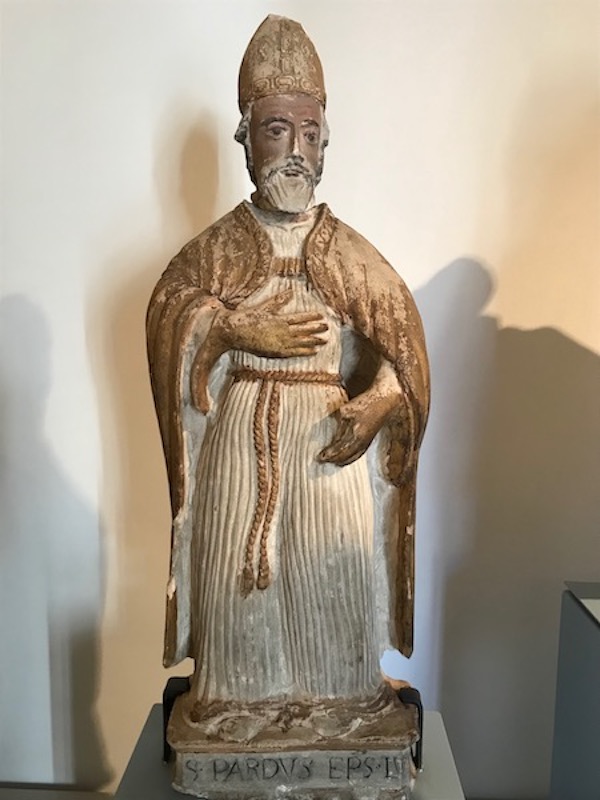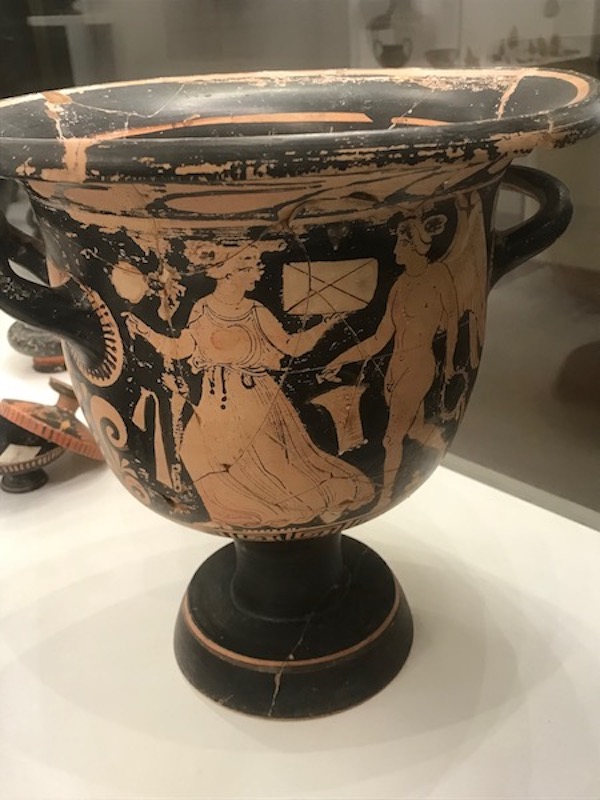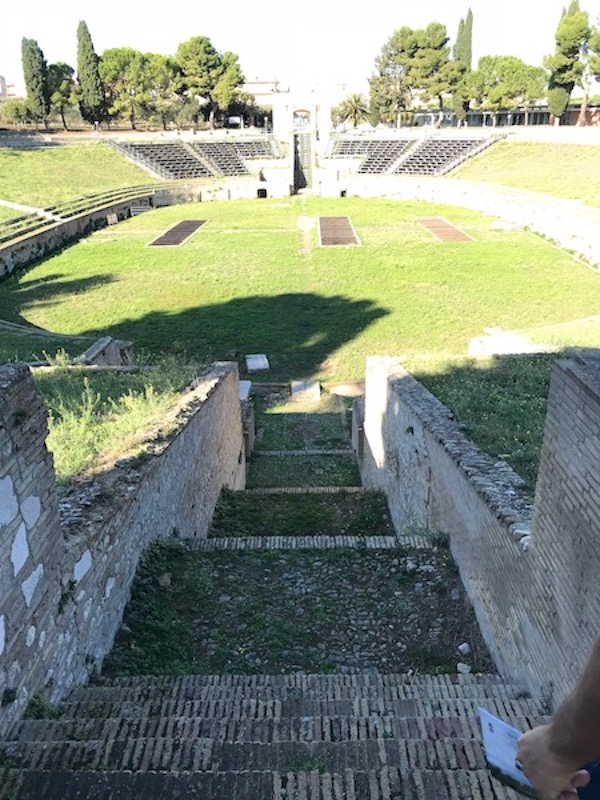Our Blog - Southern Italy - Lucera
While the Puglia region is relatively flat, we saw some nice mountains on our drive out of Naples, including some (that I didn't get pictures of) that were snowcapped. We got a quick look at Mount Vesuvius (the one that destroyed Pompeii and Herculaneum) as well as what we think are the mountains within the Parco Regionale del Partenio.




Further along, we headed through what seemed a bit of agricultural land with quite a few wind farms, and villages up on the hilltops.


Then we got into the town of Lucera. We had booked a little B&B but got an email along the drive that there was a problem with the room (the previous people hadn't check out) and so they had moved us to a room at a hotel that is owned by the same group. It was quite a large room with nice views out the window.




Lucera has an interesting history. In 321 BC, the Roman army was deceived into thinking the city was under siege by the Samnites. The army walked into an ambush and were defeated at the famous Battle of the Caudine Forks. After a revolt of the population, the city sought and was granted protection by Rome. In order to strengthen the ties between the two cities, 2,500 Romans moved to Lucera and from then on, was known as a steadfast supporter of Rome. Fast forward to the 1200's and the time of Holy Roman Emperor Frederick II, who ended up doing a LOT of building in the Puglia area during his reign. Also during his reign, the Muslim population grew due to Muslims being expelled from Sicily. They worked mainly as farmers and their numbers grew to approximately 20,000 in Lucera. However, the majority were either slaughtered or sold into slavery in 1300 by Christian forces under Charles II of Naples.
Our friend, Valentina, is always talking about how Italian coffee is much better than what we get in Toulouse and so, of course, one of the first things we did was stop to get a coffee. Mind you, the espresso is much smaller and much stronger here, which is probably why Valentina is not very happy with the French espresso.

By the time we got to Lucera, checked into the hotel, and had our coffee, most things were closed. What we are finding out is that places close for lunch and, basically, the afternoon. From about 12:30 or 1 until, in some cases, 5pm. Even the church, that we wanted to go to, ended up being closed until about 4 or so. We did find the Museo Civico "Giuseppe Fiorelli" open. Since 1936, the museum has been housed in the 18th-century De Nicastri-Cavalli palace. The museum is a bit interesting as it has old artifacts from the town and surrounding area, but also then just open rooms from the palace, including ones with frescoed ceilings. Mind you, nothing was in English there, but we got the general idea from the Italian, since it shares some words with either English or French.
Here are a few examples of the walls and ceiling decorations. They also had the palace kitchen that was still there.





Then the antiquities ... this first one is a votive statue of a young man dressed in tunic (Roman) but with the head uncovered (Hellenic) dating from the 3rd century BC.

Another from the 3rd century BC, this still has quite a bit of the original paint on it.

A marble statue (minus the head) that dates from the "first imperial age"

They also had the huge mosaic on the floor of one room, along with other mosaics on the walls. I wasn't able to really figure out where this came from, although I saw something that may have indicated a thermal bath.


Not all that old, but here is a sculpture from the 15th century of Saint Pardo (whoever he was).

And then before the Romans came (4th century BC) was the "pre-Roman" era, and there was a set of ceramic from back in that time as well.

The Duomo di Lucera, or the Lucera Cathedral, is the main site in the historical center of town. There was previously a church here from early 1200's that was turned into a mosque for a bit of time. However, Charles II of Naples ordered the mosque destroyed in 1300 and a new church built here. It was completed in 1317. The interior was changed in the 16th and 17th centuries with some Baroque decor but that was mostly removed in the 19th century. The front is asymmetrical with 3 parts: the left and central parts date from the 14th century and are quite plain with simple Gothic windows, while the more recent right-hand part has a Romanesque tower.




The interior shows a heavy French Gothic influence, with 3 aisles delineated by columns with pointed Gothic arches.


There were several altars around, including this one, the altar of Santa Maria Patrona, which was commissioned in 1779.

Another church nearby, the Church of San Francesco (Saint Francis). You may start to see some commonalities in the architecture and decoration of some of the churches. The exteriors are not very ornate, no flying buttresses as in many French Gothic churches, and they tend to be rather rectangular. On the interior, many have very high, flat, wooden ceilings and no side chapels. Behind the altar were some remnants of old frescoes.





And the Altar of Saint Francis. While not at this altar, the remains of Saint Francis of Assisi are supposedly under the main altar.


I didn't get a picture of the exterior of the Church of San Giacomo, but the interior was quite nice, and much different than the Cathedral. There has been a church here since the 7th century but in 1775, the old church was demolished because it was unsafe. Another church was built in 1852 but was actually never opened and in 1900, it was demolished and the present church built. So, it really isn't that *old* of a church by European standards.





The church of San Giovanni Battista dates back to 1558 and sits near one of the old city gates, Porta Foggia. However, there was some serious reconstruction work carried out in the 19th century and so the interior looks very ornate and well-kept. It is much smaller with a much lower ceiling (like the Church of San Giacomo) than that of the Church of San Francesco or the Cathedral.





Time for the afternoon break ... a latte with cannoli!

The Castle and Swabian-Angevin Fortress is located on the highest hill of Lucera. A castle was built in 1233 by Frederick II and the surrounding walls were added between 1269 and 1283 by Charles I of Anjou. This allowed him to change the purpose of the structure from a palace to a fortified castle and permanent military garrison. Within the walls, he built military barracks, a munitions factory, and a small village for people to live. The irregular wall that surrounds the entire hill on which stands the castle is 900 meters long, and also consists of 13 square towers, two pentagonal bastions, 7 buttresses and two cylindrical corner towers. If I understood the Italian person who sold us the tickets, this is the largest fortress (I assume in area) in Europe.


Once we got inside, there was no way to get a good picture and so I did a 360 degree video ....
Within the interior, you can see remnants of the buildings and sewer channels.



The large round tower, the Queen's Tower or Lioness' Tower, is 25 meters tall and 14 meters wide. Inside, they had a really nice video with a reconstruction of how it would have looked on the inside when it was a military fortress. I grabbed this picture of the video screen to try to give you also a view of it.

Then pictures from the top of the tower, along the walls and to the inside.




Then we headed across town to the Roman Amphitheater. They had a decent drawing of what the Roman city may have looked like back in the 1st century BC, with the Amphitheater being all the way over on the right. It is built by Marco Vecilio Campo, an important magistrate, in honor of Octavian Augustus. You can see part of this in the inscription above the door (VECILIVS .... CAMPVS and then AMPHITHEATRVM and PRIVATO since it was built with the funds from a private individual).



It was built to host gladiator games and could hold up to 18,000 spectators. You can see newer seats on one end, which is used today for entertainment and cultural events. It actually fell into disuse in the Middle Ages and ended up being covered over, and it was rediscovered in 1932.




